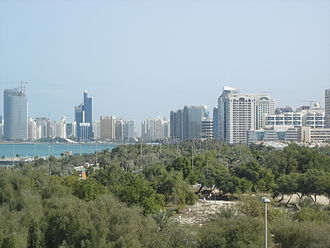Abu Dhabi
Abu Dhabi (Arabic: أبو ظبي, ʼAbū Ẓaby) is the capital city of the United Arab Emirates. It is in the emirate of Abu Dhabi. Abu Dhabi is one of the seven emirates which form the United Arab Emirates(UAE). The city is on a T-shaped island going into the Persian Gulf from the central western coast. The city is 972 km2 in size. The city had a population of 1.45 million people in 2022. Abu Dhabi is also the capital of UAE and is the largest emirates in UAE.[1]
History
People started to live in the area and call it Abu Dhabi about 300 years ago. In the 1970s, the Bani Yas tribe made Abu Dhabi their capital city. Shakhbut bin-Dhiyab Al Nahyan became the leader of the city in 1818. People found oil in 1958 in Abu Dhabi. They started to sell the oil in the 1960s. In 1971 December the 2nd, Abu Dhabi joined the United Arab Emirates and became the capital city.
Weather
Abu Dhabi is in a desert and has a desert climate. There is not a lot of rain but it does rain a little in the winter months. The average rainfall per year is 51 cm. It can also be very hot. In the daytime, the average summer temperature is 42 °C. The average daytime temperature in the winter is more comfortable at 23 °C.
Tourism
Abu Dhabi has many tourist attractions such as the Sheikh Zayed Mosque, Abu Dhabi Louvre Museum, Mangrove Kayaking Tours, Ferrari World, the Emirates Palace, Qasr Al-Hosn, bout towers, Abu Dhabi According to the Department of Culture and Tourism. The usual amount of people that come in Abu Dhabi is 10 million per year. Abu Dhabi also has Jabal Hafeet, which is the tallest mountain in the UAE.
Abu Dhabi Media
Sheikh Shakhbut bin Sultan Al Nahyan, brother of Sheikh Zayed, ruled Abu Dhabi from 1928 to 1966
Abu Dhabi seen from Sentinel-2, European Space Agency
Decorated stone cup from Umm Al Nar site, Abu Dhabi on display at the Louvre Abu Dhabi
- St. Paul's Church, Abu Dhabi.jpg
An Airbus A380 belonging to Etihad Airways, the second-largest airline in the UAE after Dubai-based Emirates
References
- ↑ United Arab Emirates: largest cities and towns and statistics of their population Archived 2013-07-23 at the Wayback Machine. World Gazetteer.











